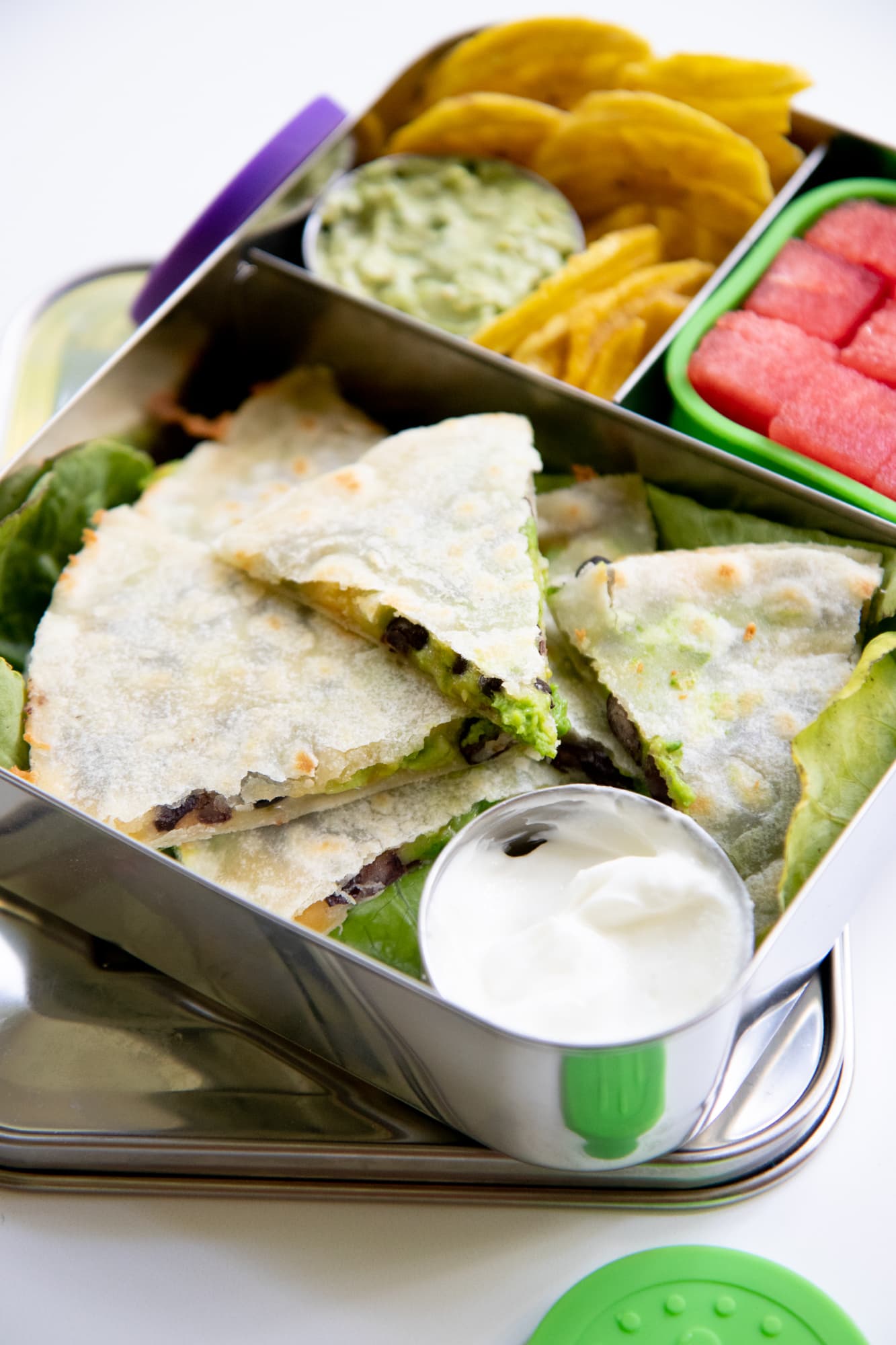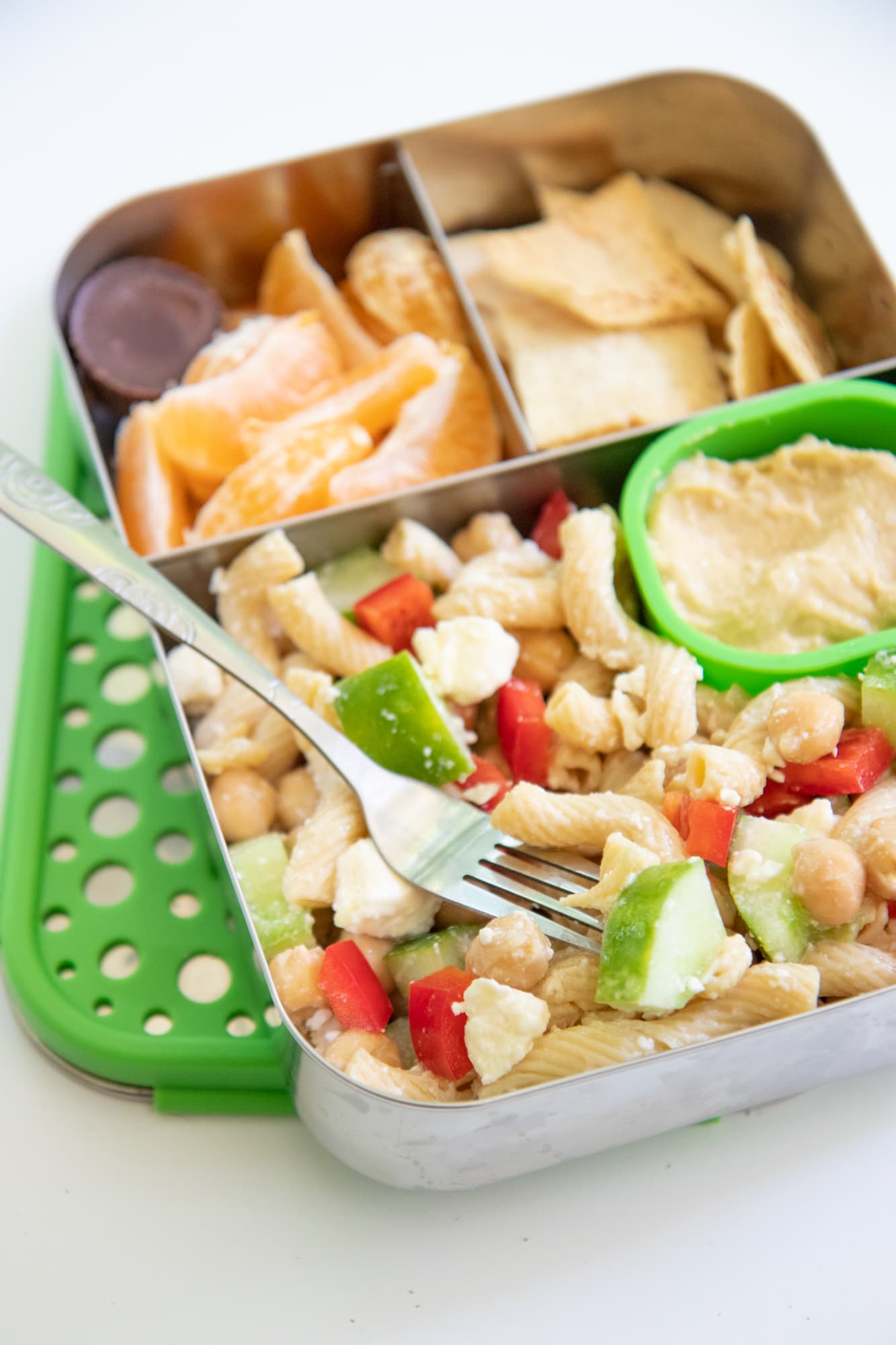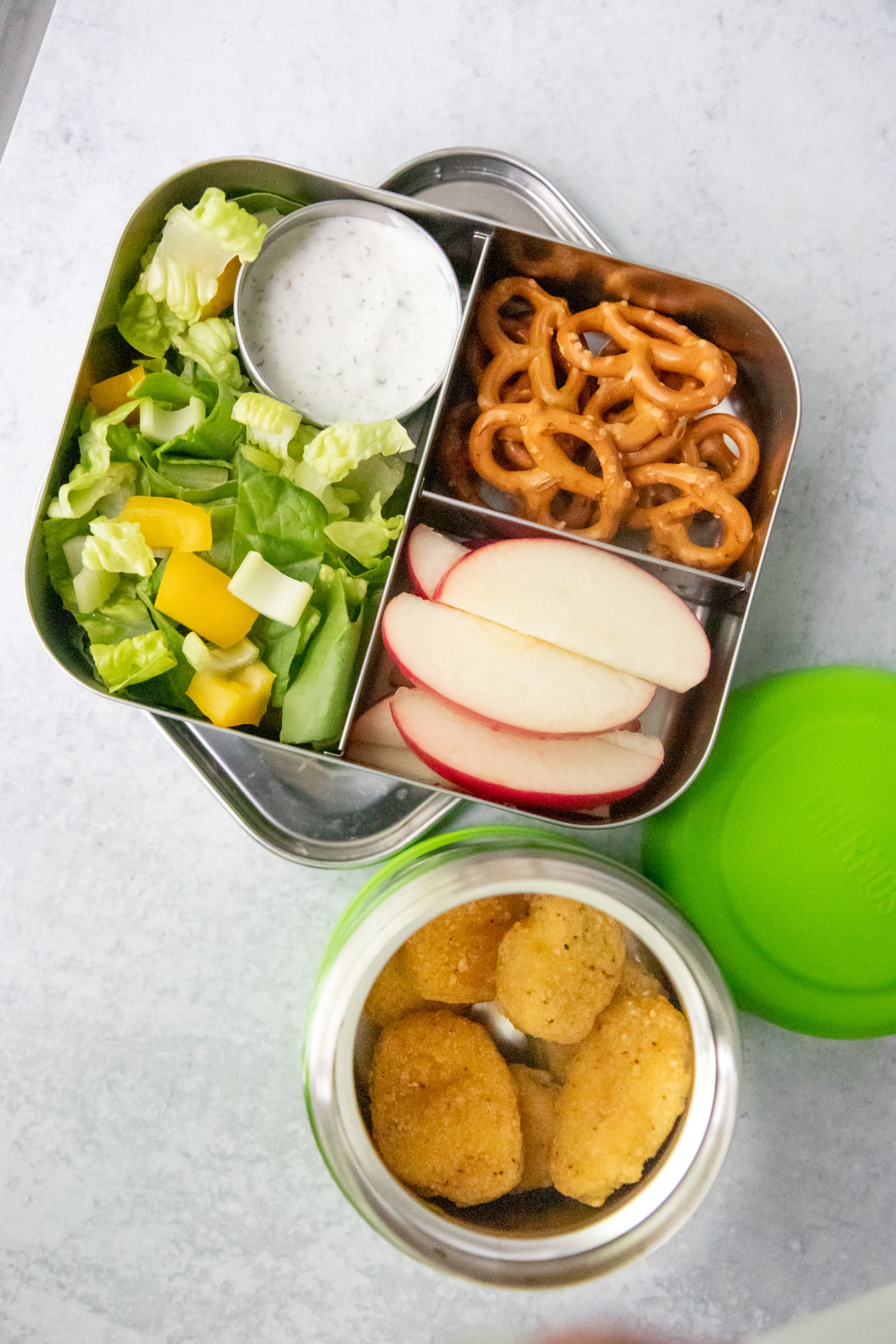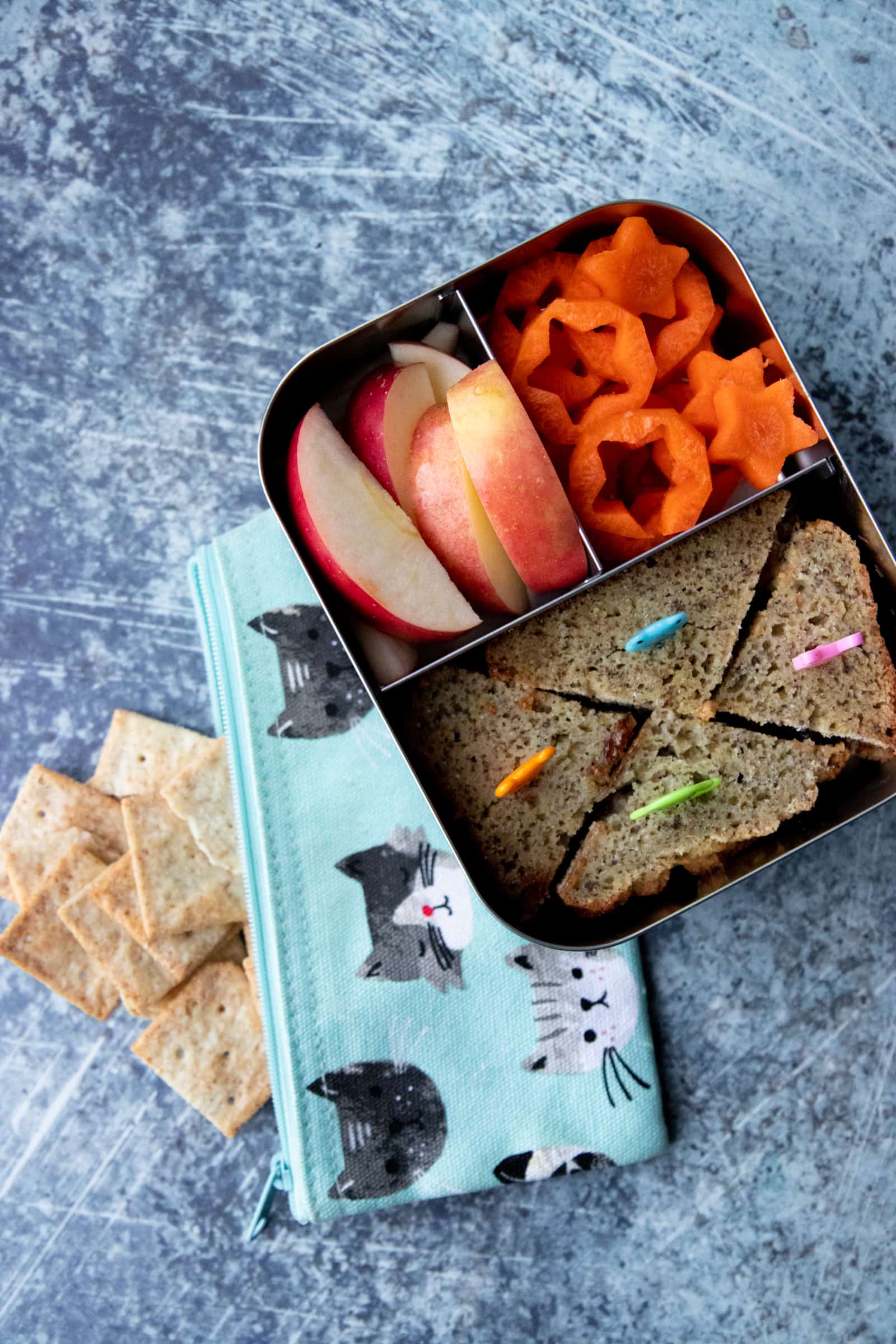Want all this information in an easily downloadable form? Check out our Ultimate Guide to Healthy School Lunches ebook!
When my daughter started school for the first year, there was a note about our school’s lunch packing guidelines in the deluge of back-to-school emails (SO MANY EMAILS).
The Ultimate Guide to Healthy School Lunches
We’ve packed (pun intended!) all our knowledge from years of making school lunches into one digital master guide!
There were items that you’d expect—like a note telling us to please keep the cupcakes at home—but there was also something that stuck out to me as both unusual and wonderful! Our school requested that student’s packed lunches be as waste-free as possible. It isn’t a mandate, but all families are asked to try to keep plastic baggies, pre-packaged foods, and disposable food wraps to a minimum.

I was so excited to see this recommendation! While sometimes life gets in the way and you have to take the shortcut (those little cups of hummus with pretzels attached have saved my life more than once), I love seeing a large school working hard to do it’s part to reduce its environmental impact.
And amazingly, what we found out was that once you have the right tools, zero-waste lunch packing is actually pretty darn easy! Yes, it takes a little bit of investment from the get-go to get the supplies, but considering they’ll last for years, you end up saving money in the long run over their disposable counterparts.

I share a lot of our school lunches over on Instagram, and I’m constantly getting asked what tools we use and how we deal with certain foods without baggies, plastic wrap, or plastic containers (while many plastic containers are multi-use, we also don’t use plastic in our zero-waste lunch-packing—or when it comes to food storage in general). So I pulled all the answers out of my DMs and put everything into one post for easy reference.
What is zero-waste lunch packing?
Before we dig into the how, let’s wrap our brains around a definition of what zero-waste lunch packing actually means. In my mind, it means that the individual lunches do not create any more waste—no paper napkins, no plastic utensils, no yogurt cups, no squeeze applesauces, etc. Basically, at the end of my daughter’s lunch period, she shouldn’t need to go to the trash can or recycling at all.
Of course, the actual lunch itself is the last step in the packaging waste chain—you also have to consider the packaging the food comes in from the store and how it’s shipped and handled before that. That’s a little beyond the scope of this post, but do know that we try to eliminate single-use packaging earlier in the supply chain as well—we buy in bulk where we can, use reusable bags and containers for grocery shopping, and cook from scratch.

What tools are absolutely necessary for zero-waste lunch packing?
This list is going to differ for every family, but if you’re looking for a starting point for formulating your own “must get” list, here’s what I’d recommend:
Reusable snack bags: We have a tutorial for how to make them, but you can also purchase them. I’ve tried a lot of different brands over the years, and this multi-pack from The Art of Lunch is my favorite. I like that it’s a zipper—velcro can be great, but it also does tend to get food stuck in it—and the fabric is pretty stain-resistant. Plus, the prints are gorgeous!
Big food containers: While we use a lot of glass containers in our home for food storage, for a five-year-old carrying lunch back and forth each day, we like metal better for school lunch packing. You can choose individual containers, like this set from U-Konserve, which we love because the lids are leak-proof. Or, you can choose to go more bento style—I’m a total LunchBots loyalist and have every LunchBots ever made. But if I had to choose just one, it’d be the Large Cinco. Yes, they are pricey, but I’ve had LunchBots that I’ve used every day for over five years that look brand new. You definitely can’t do that with plastic food storage containers!

Dip/condiment containers: Condiments and dips are where a lot of people get hung-up with the zero-waste thing—hummus cups, guacamole cups, salsa cups, ranch cups—they’re just so easy to grab and go! But having good quality leak-proof condiment cups makes it almost as easy to pack those dips. You also save a ton of money! Have you ever added up how much you’re paying for 1/4 cup of ranch dressing? PHEW. This is again where LunchBots rocks. I like their Dips containers in the 1.5 ounce size for all things condiments. Make sure to get the ones with the silicone lids—they also sell an (older) version with stainless lids that work really well for a year or two, but then the seals start to fail. The silicone ones have been top notch for us!

Liquid food containers: If you want to stop packing applesauce packets or yogurt cups, then you’ll need a way to pack liquid-y food without it getting on everything in the lunchbox. Again, the U-Konserve cups work here, but I really like the LunchBots (shocker) Leakproof Rounds because the lids are secure, yet easy enough for my kid to get off to get to her yogurt. The U-Konserve cups can be a bit hit or miss for her getting them open without asking for help.
Utensils: Unless you intend to pack only finger food (which if you do, more power to you!), you’ll need to provide reusable utensils. Any cheap stainless utensils will work—check the Goodwill!—but I ended up splurging on these sets with cases. I like that the utensils are contained, because it makes me feel like they’re less apt to get lost (and *knock on wood* we haven’t lost one in a year).

Water bottle and lunchbox: I think most schools nowadays allow (and recommend) kids to bring a reusable water bottle. I also think gone are the days where kids shuttle their lunches back and forth in paper bags. If you’re looking for my recommendation on these, these are the water bottles my daughter uses (we have them in multiple sizes and colors) and this is the lunchbox we’re using this year. I’m still not 100% sold on the lunchbox, but it does fit the biggest LunchBots container flat in the bottom, so that’s a big win in my book. We used this lunchbox last year, and it also fit the biggest LunchBots container flat, but it couldn’t do that AND fit a water bottle, so it was decommissioned. Which is unfortunate, because it held up really well throughout the year!
Napkins: Messy kids need napkins. You can buy some cheap napkins from a discount store, but I ended up just making my own flannel napkins using scrap flannel I had kicking around. I used the same method I outlined here to make flannel wipes, I just made the napkins 14” square instead of the 8” square the wipes are. I do recommend having enough to get through a full week or two of lunch per kid—because if your house is anything like mine, sometimes laundry just doesn’t get done, man.
What tools are fun add-ons for zero-waste lunch packing?
If you’re looking to really go all-in, you might want to look at a few of these items—I don’t use these everyday, but they’re certainly nice to have.
Bee’s Wrap: If you’re looking for a zero-waste alternative to plastic wrap, aluminum foil, or parchment paper for wrapping sandwiches, Bee’s Wrap is a great option. We have a lot of Bee’s Wrap in our house for food storage purposes, but I rarely use it in lunch packing because I don’t pack a lot of sandwiches! And when I do, they are usually half-sandwiches that fit just fine in our bento containers. Once my daughter is older and has a bigger belly to fill up, we’ll probably use more Bee’s Wrap for sandwiches.
Thermos: Even though my daughter has access to a microwave in her classroom, we still send hot foods frequently in her Thermos Funtainers. Thirty students, one microwave—you do the math. We send soups, grilled cheese, chicken nuggets, fish sticks—anything that needs to stay warm. Things do tend to get a touch soggy in there, but not enough that my daughter minds.

Picks and skewers: If you’re packing finger food, you’ll eventually want to use toothpicks or skewers to hold something together—which creates waste. Instead, we use reusable picks and skewers in lunches. While there are a few stainless steel options, we did go with plastic here for two reasons—(A) c’mon, they’re adorable (B) these little things do tend to go missing throughout the year more than anything else in the lunchbox. These are the picks we use daily and these are the skewers we use. I also have this Halloween and Christmas set, which makes my kid super happy.

Dividers: If you’re using bento-style boxes, you’ll probably want some sort of divider to keep different foods separate (and in the case of LunchBots, to keep wet foods from infiltrating dry—the sections are not water-tight). You can just use regular silicone muffin cups, but I do really like the silicone dividers from LunchBots, just because they are sized to fit perfectly in the sections of LunchBots.
Vegetable cutters: Getting kids to eat veggies is way easier when they’re in fun shapes, it’s just a fact. I don’t always cut food into shapes, but if I have a few extra minutes, I might pull out these vegetable cutters. They also work great on sliced cheese and lunchmeat.

How do you store all of the tools for zero-waste lunch packing?
This isn’t just a zero-waste lunch packing problem, it’s just a lunch packing problem in general! Where do you keep all this stuff so it’s easy to access and keep organized? Well, we solved this problem by putting it all in a special lunch packing cart.

This utility cart (from IKEA, though we’ve seen something similar at Michael’s) lives in the corner of our breakfast nook and contains all of our supplies for zero-waste lunch packing. This has worked beautifully for us! When it’s time to pack lunch, I roll the cart to the kitchen island. When I’m done, I roll it back. It saves so much time not having to hunt down the lid for this or the container for that—it’s all in one organized spot.
We have thermoses and the lunchboxes themselves (I have mine in there too, because I pack too!) on the bottom shelf, then the next shelf are our large containers, and the top shelf is where all of our small containers, utensils, and accessories go.

How do I send {insert speciality food here} without {insert single-use plastic here}?
Let me cover a few of the most common specific food items I get asked about over on Instagram. If I don’t cover what you have a question about, DM me on IG or shoot us an email and I’ll give you some ideas!
Yogurt or applesauce: Now that my kid is older, they go into LunchBots Leakproof Rounds. The lids screw on, making them easy to open for kids, but they are still leak-proof. When she was younger, we used these silicone squeeze pouches a lot.
Cheese sticks: Man, does my kid love cheese sticks and string cheese, but man, do I hate that each one is individually wrapped. I’ll buy full blocks of cheese and then cut them into either sticks or cubes and store them in the fridge in a container. Then to pack in the lunch, I just put it in one of the sections of the LunchBots we’re using that day.
Apples/avocados/anything that oxidizes: Instead of buying bags of apple slices or wrapping our avocados in plastic wrap, I treat all oxidizing food with Ball Canning Fruit Fresh and store it in our everyday stainless containers.

Hot foods: We heat in the morning, and then transfer to Thermos Funtainers. Crispy baked foods (sweet potato fries, chicken nuggets, grilled cheese, etc.) will get a bit soggy, but not so much my kid doesn’t want to eat them.
Sandwiches: I make small enough sandwiches that they fit into the bigger sections of our LunchBots boxes. But if I needed more room, I’d wrap them in Bee’s Wrap or slide them into a large reusable snack bag.
Doesn’t your kid lose this stuff at school?
I get this question all the time, and to be honest, no. She really doesn’t. We’ve lost a napkin or two, and a few of the plastic picks, but everything else has come home. It could be a product of a few things. First of all, she’s never known any differently—she’s young enough that zero-waste lunches are all she’s ever had at school and she knows everything comes back.
Secondly, we label, label, label. Since my daughter eats lunch in her classroom instead of a lunchroom, anything that is “lost” stays in the classroom and when it is “found,” it is just rerouted by her teachers to the right kid. She’s come home with extra napkins or extra utensils in her lunchbox from previous lunches that were “lost” but made their way back home because we had labeled them. We’ve never had a big container go missing.

I hope this post has inspired you to get started reducing your waste while packing school lunches. Do you have to do it all? Heck no! Maybe this school year, you just start using reusable snack bags instead of plastic baggies. And then next year you can pick another area to turn zero-waste—this doesn’t have to be an overnight change. Happy packing!





